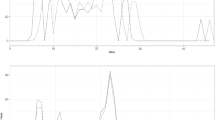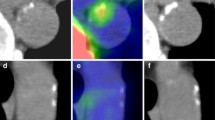Abstract
Background
Fluoride-18 sodium fluoride (18F-NaF) localizes in microcalcifications in atheroma. The microcalcifications may aggregate, passing the resolution threshold to visualize on computed tomography (CT). We evaluated serial NaF positron emission tomography (PET)-CT scans to determine the temporal relationship between vascular NaF uptake and CT evident calcification in the abdominal aorta.
Methods
Prostate cancer patients who had at least 3 NaF PET-CT scans over at least 1.5 years were retrospectively enrolled. Regions of interest were traced in the abdominal aorta on both PET and CT images, excluding skeletal NaF activity. The maximum standardized uptake value (SUVmax) of NaF and the density and volume of calcium (exceeding 130 HU) were summed and divided by the number of slices to produce the SUVmax/slice and the mm3·slice−1 of calcium.
Results
Of 437 patients, 45 patients met criteria. NaF uptake waxed and waned between scans, while the calcium volume plateaued or increased over time. NaF uptake correlated with calcium volume on the baseline scan (P = .60, < .0001†) and calcium volume increment, especially from 1.0 to 1.5 years (r = .79, P < .0001†). Patients with persistently high NaF uptake showed a higher calcium volume increment (0-1.5 years) than patients with low or transiently high NaF uptake.
Conclusions
Abdominal aortic NaF uptake varied over time. NaF uptake on the baseline scans and high NaF uptake on the serial scans preceded an increase in calcium volume, especially by 1.0-1.5 years. Persistently high NaF uptake was associated with a greater increment in calcium volume than patients with transiently elevated or persistently low fluoride uptake.






Similar content being viewed by others
Abbreviations
- 18F-NaF:
-
Fluoride-18 sodium fluoride
- CT:
-
Computed tomography
- SUVmax :
-
The maximum standardized uptake value
- mm3·slice−1·year−1 :
-
The increment in volume of vascular calcification
- Plaque:
-
Atheroma
- PET-CT:
-
Positron emission tomography/computed tomography
- ROIs:
-
Regions of interest
- IQR:
-
Inter quartile range
- DSCF:
-
Dwass-Steel-Critchlow-Fligner
- HTN:
-
Hypertension
- CAD:
-
Coronary artery disease
References
Agatston AS, Janowitz WR, Hildner FJ, Zusmer NR, Viamonte M Jr, Detrano R. Quantification of coronary artery calcium using ultrafast computed tomography. J Am Coll Cardiol 1990;15:827-32.
Mark DB, Berman DS, Budoff MJ, et al. ACCF/ACR/AHA/NASCI/SAIP/SCAI/SCCT 2010 expert consensus document on coronary computed tomographic angiography: A report of the American College of Cardiology Foundation Task Force on Expert Consensus Documents. J Am Coll Cardiol 2010;55:2663-99.
Narula J, Nakano M, Virmani R, Kolodgie FD, Petersen R, Newcomb R, et al. Histopathologic characteristics of atherosclerotic coronary disease and implications of the findings for the invasive and noninvasive detection of vulnerable plaques. J Am Coll Cardiol 2013;61:1041-51.
Shanahan CM. Inflammation ushers in calcification: A cycle of damage and protection? Circulation 2007;116:2782-5.
Shaw LJ, Narula J, Chandrashekhar Y. The never-ending story on coronary calcium: Is it predictive, punitive, or protective? J Am Coll Cardiol 2015;65:1283-5.
Nakahara T, Dweck MR, Narula N, Pisapia D, Narula J, Strauss HW. Coronary artery calcification: From mechanism to molecular imaging. JACC Cardiovasc Imaging 2017;10:582-93.
Nakahara T, Strauss HW. From inflammation to calcification in atherosclerosis. Eur J Nucl Med Mol Imaging 2017;44:858-60.
Derlin T, Richter U, Bannas P, Begemann P, Buchert R, Mester J, et al. Feasibility of 18F-sodium fluoride PET/CT for imaging of atherosclerotic plaque. J Nucl Med 2010;51:862-5.
Fiz F, Morbelli S, Piccardo A, Bauckneht M, Ferrarazzo G, Pestarino E, et al. (1)(8)F-NaF uptake by atherosclerotic plaque on PET/CT imaging: Inverse correlation between calcification density and mineral metabolic activity. J Nucl Med 2015;56:1019-23.
Blomberg BA, Thomassen A, de Jong PA, Simonsen JA, Lam MG, Nielsen AL, et al. Impact of personal characteristics and technical factors on quantification of sodium 18F-fluoride uptake in human arteries: Prospective evaluation of healthy subjects. J Nucl Med 2015;56:1534-40.
Blomberg BA, de Jong PA, Thomassen A, Lam MGE, Vach W, Olsen MH, et al. Thoracic aorta calcification but not inflammation is associated with increased cardiovascular disease risk: Results of the CAMONA study. Eur J Nucl Med Mol Imaging 2017;44:249-58.
Nakahara T, Narula J, Strauss HW. Calcification and inflammation in atherosclerosis: Which is the chicken, and which is the egg? J Am Coll Cardiol 2016;67:79-80.
Strauss HW, Narula J, Nakahara T. Finding calcium in noncalcified lesions: (1)(8)F-fluoride offers insights into atheroma evolution. J Nucl Med 2015;56:974-5.
Nakahara T, Narula J, Strauss HW. Molecular imaging of vulnerable plaque. Semin Nucl Med 2018;48:291-8.
Nakahara T, Narula J, Tijssen JGP, Agarwal S, Chowdhury MM, Coughlin PA, et al. 18F-fluoride positron emission tomographic imaging of penile arteries and erectile dysfunction. J Am Coll Cardiol 2019;73:1386-94.
New SE, Goettsch C, Aikawa M, Marchini JF, Shibasaki M, Yabusaki K, et al. Macrophage-derived matrix vesicles: An alternative novel mechanism for microcalcification in atherosclerotic plaques. Circ Res 2013;113:72-7.
Kelly-Arnold A, Maldonado N, Laudier D, Aikawa E, Cardoso L, Weinbaum S. Revised microcalcification hypothesis for fibrous cap rupture in human coronary arteries. Proc Natl Acad Sci USA 2013;110:10741-6.
Motoyama S, Kondo T, Sarai M, Sugiura A, Harigaya H, Sato T, Inoue K, et al. Multislice computed tomographic characteristics of coronary lesions in acute coronary syndromes. J Am Coll Cardiol 2007;50:319-26.
Pugliese G, Iacobini C, Blasetti Fantauzzi C, Menini S. The dark and bright side of atherosclerotic calcification. Atherosclerosis 2015;238:220-30.
Janssen T, Bannas P, Herrmann J, Veldhoen S, Busch JD, Treszl A, et al. Association of linear 18F-sodium fluoride accumulation in femoral arteries as a measure of diffuse calcification with cardiovascular risk factors: A PET/CT study. J Nucl Cardiol 2013;20:569-77. https://doi.org/10.1007/s12350-013-9680-8.
Dweck MR, Chow MW, Joshi NV, Williams MC, Jones C, Fletcher AM, et al. Coronary arterial 18F-sodium fluoride uptake: A novel marker of plaque biology. J Am Coll Cardiol 2012;59:1539-48.
Li X, Heber D, Cal-Gonzalez J, Karanikas G, Mayerhoefer ME, Rasul S, et al. Association between osteogenesis and inflammation during the progression of calcified plaque evaluated by 18F-fluoride and 18F-FDG. J Nucl Med 2017;58:968-74.
Ishiwata Y, Kaneta T, Nawata S, Hino-Shishikura A, Yoshida K, Inoue T. Quantification of temporal changes in calcium score in active atherosclerotic plaque in major vessels by 18F-sodium fluoride PET/CT. Eur J Nucl Med Mol Imaging 2017;44:1529-37.
Jenkins WS, Vesey AT, Shah AS, Pawade TA, Chin CW, White AC, et al. Valvular (18)F-fluoride and (18)F-fluorodeoxyglucose uptake predict disease progression and clinical outcome in patients with aortic stenosis. J Am Coll Cardiol 2015;66:1200-1.
Acknowledgments
SNMMI Wagner-Torizuka Fellowship and Uehara Memorial Foundation Fellowship to TN. Thanks to Dr. J. Kalaigian and Dr. C. Qing for their technical support of workstations.
Disclosure
No relationships with industry for this study.
Author information
Authors and Affiliations
Corresponding author
Additional information
Publisher's Note
Springer Nature remains neutral with regard to jurisdictional claims in published maps and institutional affiliations.
The authors have also provided an audio summary of the article, which is available to download as ESM, or to listen to via the JNC/ASNC Podcast.
Electronic supplementary material
Below is the link to the electronic supplementary material.
Rights and permissions
About this article
Cite this article
Nakahara, T., Narula, J., Fox, J.J. et al. Temporal relationship between 18F-sodium fluoride uptake in the abdominal aorta and evolution of CT-verified vascular calcification. J. Nucl. Cardiol. 28, 1936–1945 (2021). https://doi.org/10.1007/s12350-019-01934-2
Received:
Accepted:
Published:
Issue Date:
DOI: https://doi.org/10.1007/s12350-019-01934-2




